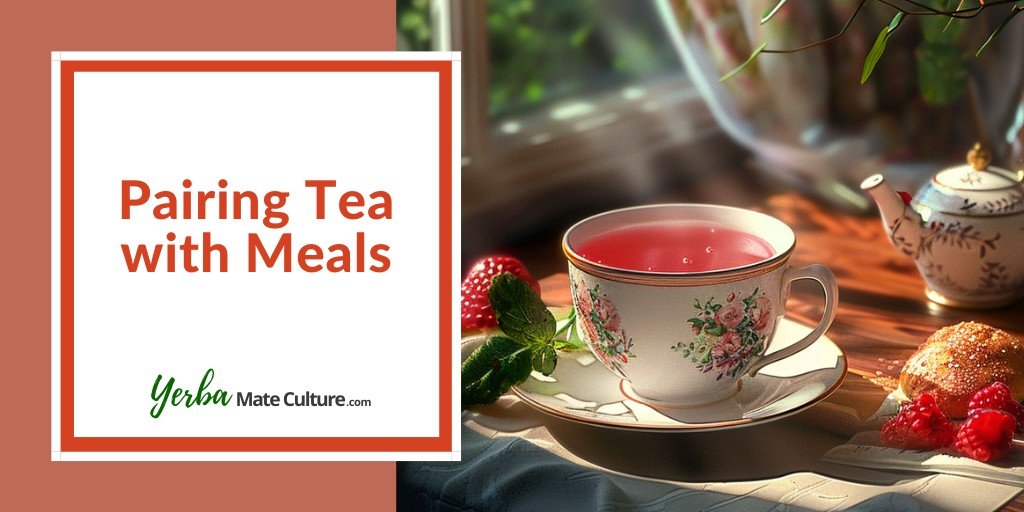Embarking on the artful journey of pairing tea with your meals is akin to unlocking a hidden garden of flavors, where each leaf whispers secrets of aroma, body, and essence. Whether you’re cooking at home or ordering at a restaurant, this will elevate your dining experience to a new realm of exquisite pleasure!
Tea, in its myriad forms, from the grassy vigor of a Japanese Sencha to the deep, malty embrace of an Assam black tea, holds the power to complement, contrast, and enhance the flavors of a meal, transforming the mundane into the magnificent.
Just as a chef orchestrates ingredients to create harmony on a plate, the art of tea pairing is about finding the perfect balance between the tea’s character and the food’s flavor profile.
In this guide, we will explore how to navigate the intricate dance of flavors when pairing tea and food. We’ll delve into the principles that underpin successful tea and food pairings, offer practical tips for beginners, and provide insightful recommendations for pairing tea with various cuisines.
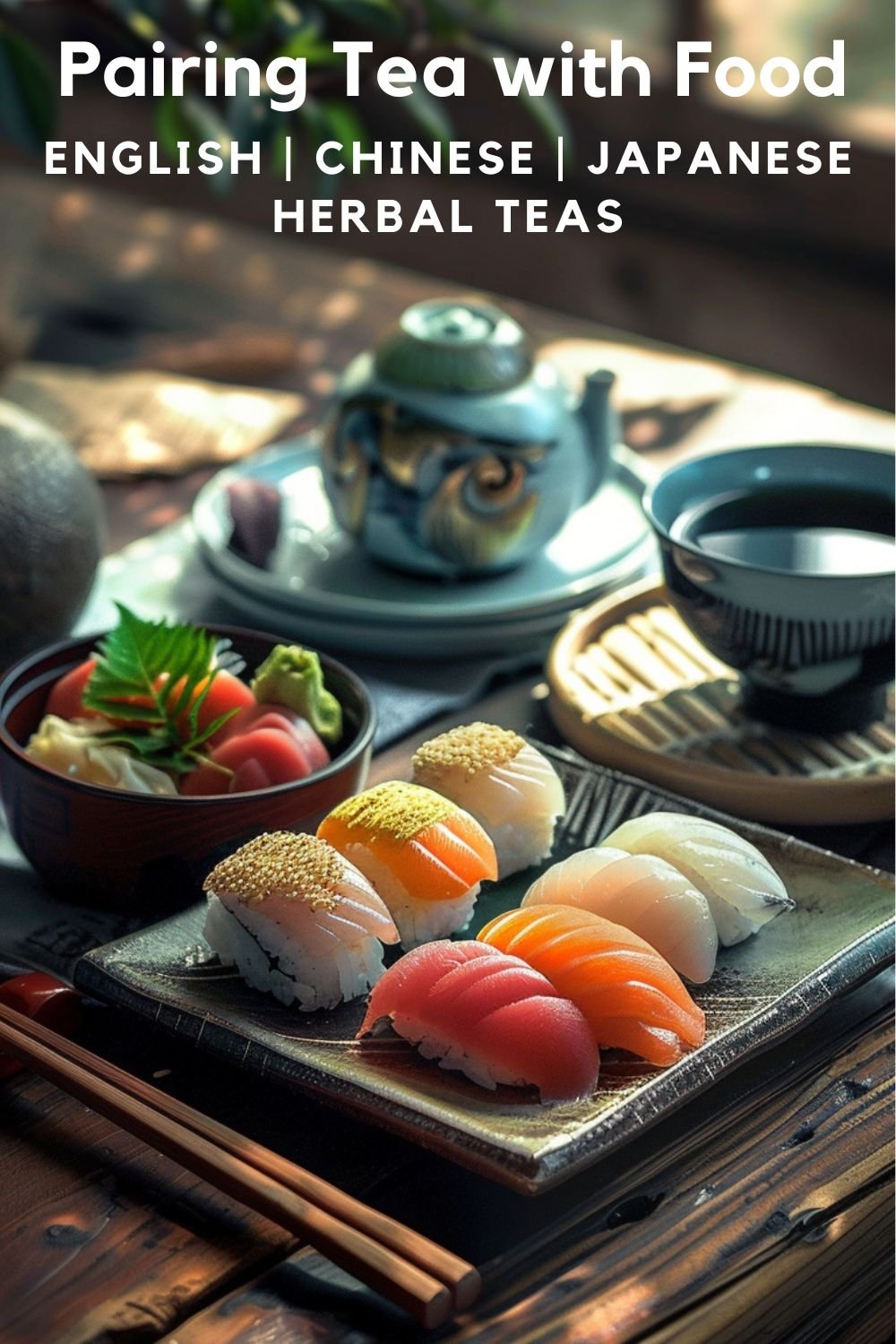
Whether you’re a fervent foodie seeking to add another layer of enjoyment to your meals or a tea lover looking to deepen your appreciation of this ancient beverage, this guide promises to open new avenues of taste and pleasure. Join me in elevating your dining experience, where each sip and bite becomes a moment of discovery and delight!
English Breakfast Tea and Food Pairing
English Breakfast Tea stands as a cornerstone in the collections of tea lovers, celebrated for its potent, full-flavored profile that awakens the senses through its aromatic richness and zestful taste.
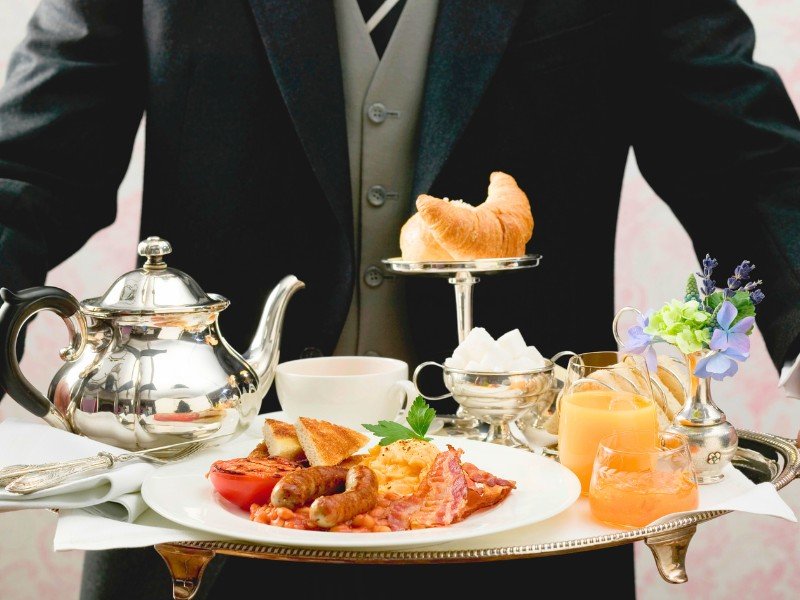
This quintessential blend, typically forged from the leaves of Assam, Ceylon, and Kenyan teas, serves as an ideal backdrop for an array of culinary pairings, enriching meals from the early morning hours until nightfall.
Its robust character renders it an adaptable partner to dishes across the spectrum—from the sweet to the savory—offering a pleasing juxtaposition that lifts the overall flavor experience of each meal.
Examples of English Breakfast Tea Pairings:
- Morning Staples: Harmonizes with traditional full English breakfast items such as fried eggs, sausages, and toast.
- Sweet Treats: Enhances the enjoyment of morning pastries, including croissants and scones with jam. Read this guide on tea party desserts for more ideas!
- Afternoon Snacks: Pairs well with light sandwiches or rich, buttery biscuits in the afternoon.
- Hearty Dinners: Complements the flavors of roasted meats and savory pies during dinner.
- Desserts: Offers a balancing counterpoint to the sweetness of cakes and chocolates.
Chinese Tea and Food Pairing
The vast and diverse heritage of Chinese tea mirrors the expansive culinary traditions of China, presenting a wide array of tastes and scents. Ranging from the gentle, fragrant essence of Jasmine Tea to the rich, soil-like depth of Pu-erh, Chinese teas possess the remarkable ability to elevate the taste profiles of classic Chinese cuisine.
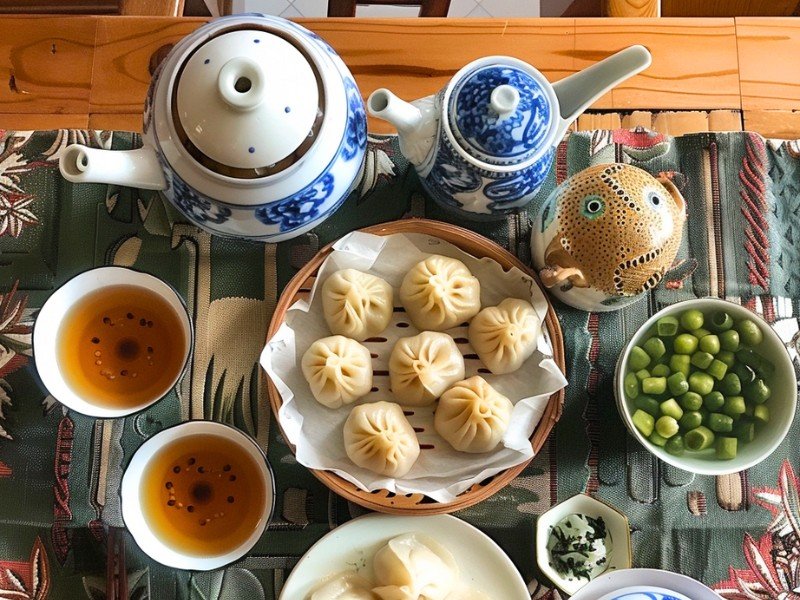
So let’s have a look at the sophisticated practice of matching these teas with various dishes, shedding light on how the proper pairing can metamorphose a simple meal into a remarkable culinary journey.
Examples of Chinese Tea and Food Pairings:
- Jasmine Tea: Complements dim sum and lightly flavored dishes, adding a floral note that enhances without overwhelming.
- Pu-erh Tea: Ideal with rich, fatty foods such as roasted duck or pork belly, cutting through the grease and aiding digestion.
- Oolong Tea: Pairs well with a variety of foods, from seafood to grilled items, accentuating the meal’s flavors with its own complexity.
- Green Tea: Best matched with vegetables or mild fish dishes, where its subtle bitterness can highlight the freshness of the ingredients.
- Black Tea: A strong partner for spicier dishes, providing a robust backdrop that complements intense flavors.
Japanese Tea and Food Pairing
The nation’s esteemed tea traditions seamlessly match the intricate equilibrium and unity characteristic of Japanese cuisine. Spanning from the verdant intensity of Matcha to the gentle, marine-infused whispers of Sencha, Japanese teas provide a sophisticated array of tastes perfectly accentuating the delicate, fresh, and umami-laden aspects of Japanese meals.
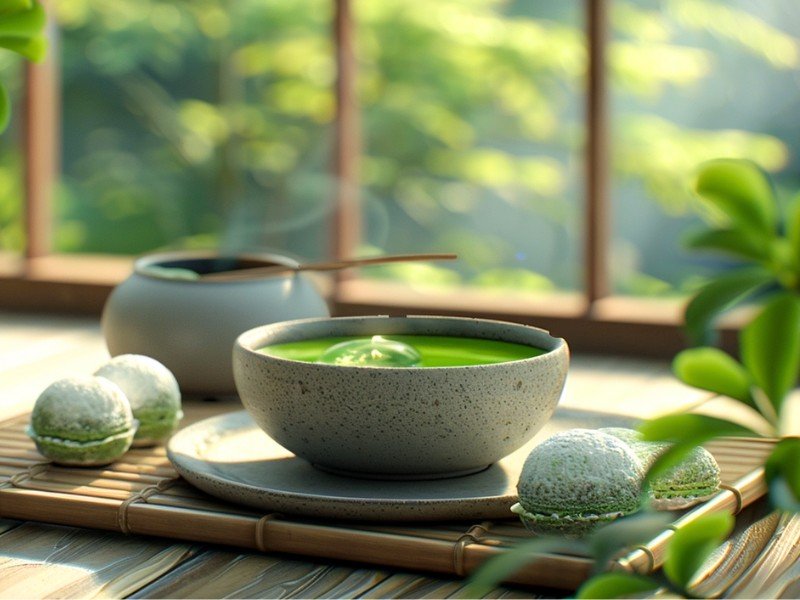
Now, let’s venture into the practice of harmonizing Japanese tea with cuisine, offering a path through pairings designed to augment and balance every mouthful.
Examples of Japanese Tea and Food Pairings:
- Matcha: Excellently pairs with wagashi (traditional Japanese sweets), where its boldness counterbalances the sweetness.
- Sencha: Complements sushi and sashimi, enhancing the natural flavors of the fish with its mild astringency.
- Gyokuro: Pairs well with dishes that have subtle flavors, such as tofu or lightly seasoned vegetables, highlighting their umami qualities.
- Hojicha: A roasted green tea that goes well with both sweet and savory dishes, especially grilled foods, offering a smoky complement.
- Genmaicha: Best enjoyed with a hearty meal like tempura or yakitori, where its nutty flavor from roasted rice balances the meal’s richness.
Tea and Food Pairing in Indian Culture
At the core of Indian culture thrives an exuberant mosaic of tastes, scents, and textures, reflecting the nation’s varied terrains and historical richness through its culinary practices. Tea, or “Chai” as it’s fondly called, stands at the forefront of this tradition, transcending its role as a mere drink to embody hospitality, warmth, and communal spirit.
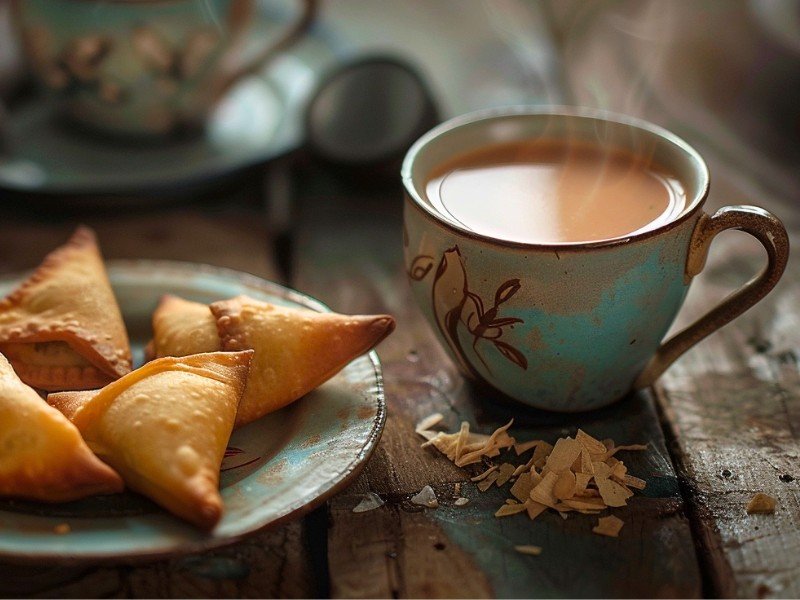
Ranging from the aromatic masala chai found in the north to the refined Darjeeling tea of the east, Indian teas present a wide array of flavors that perfectly complement and elevate the multifaceted dishes of Indian cuisine.
This portion of the guide delves into the practice of matching tea with Indian meals, offering an invitation to a celebratory feast where each sip and morsel narrates tales of cultural heritage, creativity, and the pleasure of communal dining.
Examples of Indian Tea and Food Pairings:
- Masala Chai: Perfect with street food snacks like samosas or aloo tikki, where the spices of the chai amplify the flavors of the food.
- Assam Tea: Ideal for breakfast, pairing wonderfully with parathas or poha, complementing the hearty, spicy breakfast dishes with its robust taste.
- Darjeeling Tea: Best enjoyed with lighter snacks or sweets, such as khari biscuit or sandesh, where its floral notes can shine.
- Nilgiri Tea: Pairs well with South Indian cuisine, such as dosas and idlis, providing a refreshing counterbalance to the savory flavors.
- Chai with Milk and Sugar: A versatile companion to nearly any Indian snack, especially fried foods like pakoras, enhancing the enjoyment with its sweet and creamy profile.
How to Pair Herbal Teas with Meals
In the ever-evolving realm of gastronomy, the practice of matching herbal teas with various dishes stands out as a nuanced and impactful art form. The distinctive, often healing, attributes of herbal teas can complement and elevate the flavors within a meal and offer a range of health benefits, such as aiding in digestion.
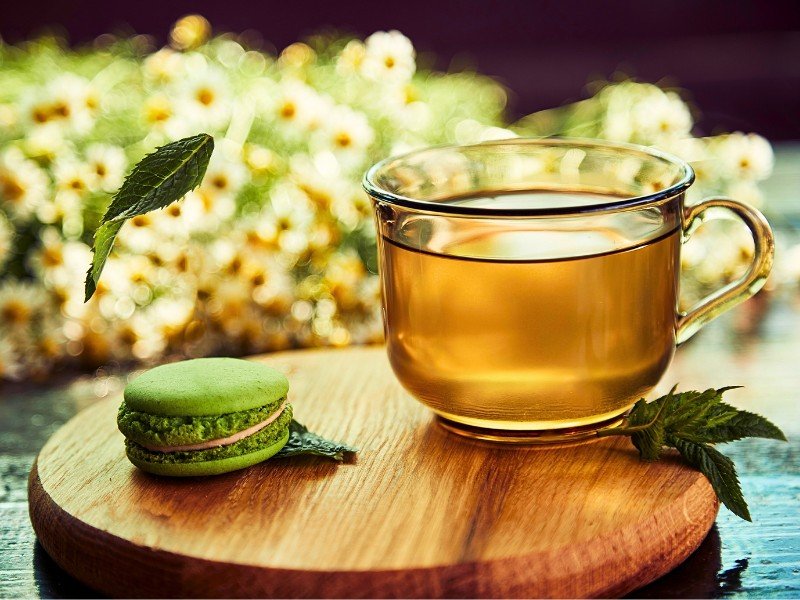
Herbal teas, or tisanes, differ from traditional teas as they originate not from the Camellia Sinensis (the tea plant) but from a diverse mix of herbs, flowers, roots, and leaves. This diversity presents a spectrum of flavors from the subtly sweet and aromatic to the distinctly earthy and sharp, enabling a vast array of food pairings.
Each pairing transforms dining into a comprehensive experience that both satisfies the palate and supports overall well-being.
Examples of Herbal Tea and Food Pairings:
- Peppermint Tea: Ideal with chocolate-based desserts or as a palate cleanser alongside spicy dishes, offering a cooling, soothing effect.
- Chamomile Tea: Pairs well with light pastries or as an after-dinner drink to unwind, thanks to its gentle, floral flavor and calming properties.
- Ginger Tea: A great match for both savory and sweet dishes, especially those incorporating fruit, providing a spicy warmth that can also aid digestion.
- Hibiscus Tea: Complements sweet, fruity desserts or sharp cheeses, with its tart flavor adding a lively contrast.
- Rooibos Tea: Versatile enough to accompany a wide range of foods, from sweet baked goods to savory grilled meats, thanks to its naturally sweet and slightly nutty taste.
Check out my complete guide for herbal teas and food pairing, if you want to read more!
Tea and Food Pairing – Experiment & Enjoy!
Mastering the art of tea and food pairing is not just about enhancing flavors; it’s a journey towards creating unforgettable dining experiences.
As we’ve explored various pairings, from the robust depths of English Breakfast Tea alongside hearty meals to the delicate whispers of various green teas with lighter dishes, it’s clear that tea offers a versatile and enriching complement to any meal.
So, the next time you sit down to dine, remember that the perfect cup of tea is not just a beverage — it’s an ingredient to a more exquisite and sensorial meal. Cheers to your journey in discovering the harmonious symphony of tea and food!

